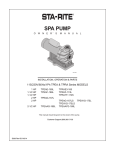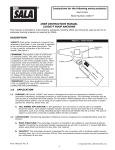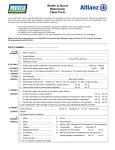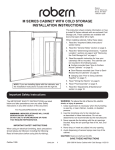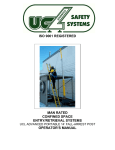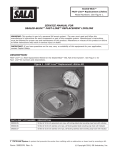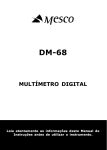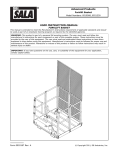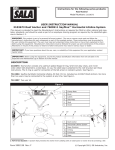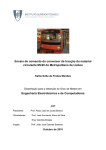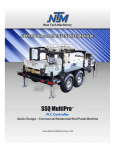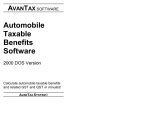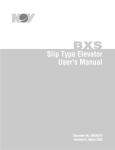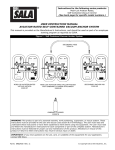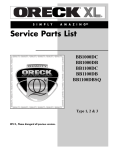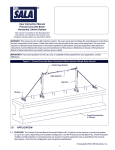Download Standing Seam Roof Anchor USeR INSTRUCTION
Transcript
Instructions for the following series products: Standing Seam Roof Anchor Model Number: 2190001 User Instruction Manual Standing Seam Roof Anchor This manual is intended to meet the Manufacturer’s Instructions, and should be used as part of an employee training program as required by OSHA. WARNING: This product is part of a personal fall arrest system. The user must read and follow the manufacturer’s instructions for each component or part of the complete system. These instructions must be provided to the user of this equipment. The user must read and understand these instructions or have them explained to them before using this equipment. Manufacturer’s instructions must be followed for proper use and maintenance of this product. Alterations or misuse of this product or failure to follow instructions may result in serious injury or death. Figure 1 - Standing Seam Roof Anchor Clamping Plate SRL Swivel Bracket Load Bar Seam Clamp IMPORTANT: If you have questions on the use, care, or suitability of this equipment for your application, contact Capital Safety. Adjustable Leg Assembly IMPORTANT: Record the product identification information from the ID label in the inspection and maintenance log in section 9.0 of this manual. 1.0APPLICATIONS 1.1PURPOSE: The Protecta Standing Seam Roof Anchor (Figure 1) is designed for use as an anchorage connector for a personal fall arrest system on sloped or flat standing seam roofs, with seam spacing from 12 inches (30 cm) to 24 inches (61 cm). The Standing Seam Roof Anchor is designed for use with the Protecta Rebel™ SRL (models 3590500 an 3590550) and other Self Retracting Lifelines (SRLs) that limit arresting forces to 1,800 pounds (8 kN) only. It is especially suited for applications where falls may occur over an edge (roofing, leading edge construction, etc.) if used with an SRL intended for leading edge work (e.g., the DBI-SALA Leading Edge Self Retracting Lifeline). 1.2LIMITATIONS: Consider the following application limitations before using this equipment: IMPORTANT: This anchor shall be installed and used under the supervision of a Qualified Person1 as part of a complete personal fall arrest system that maintains a safety factor of at least two. 1 A. ROOF PANELS: The Standing Seam Roof Anchor must only be used on structural standing seam roof panels that meet the geometric and load requirements specified in section 2.0. Refer to Table 1 for a list of compatible roof panels. B. CAPACITY: The Standing Seam Roof Anchor is designed for use by persons with a combined weight (clothing, tools, etc.) of no more than 420 lbs (190 kg). No more than one personal fall arrest system may be connected to this equipment at one time. C. FREE FALL: Personal fall arrest systems used with this equipment must be rigged to limit the free fall to six feet or less. See the personal fall arrest system manufacturer’s instructions for more information. 1 Qualified Person: An individual with a recognized degree or professional certificate, and extensive knowledge and experience in the subject field, who is capable of design, analysis, evaluation, and specification in the subject work, project, or product. Refer to OSHA 1910.66, 1926.32, and 1926.502. Form: 5902435 Rev: C 1 © Copyright 2011, DB Industries, Inc. D. FALL ARREST FORCES: The personal fall arrest system must limit fall arrest forces to 1,800 lbs (8 kN). E. Figure 2 - Swing Fall Hazard FALL CLEARANCE: There must be sufficient clearance below the user to arrest a fall before the user strikes the ground or other obstruction. The clearance required is dependent on the following factors: • Elevation of the Standing Seam Roof Anchor • Connecting subsystem length • Deceleration distance • Movement of the harness attachment element • Worker’s height • Free fall distance See the personal fall arrest system manufacturer’s instructions for more information. F. SWING FALLS: See Figure 2. Swing falls occur when the user is at a location other than in-line with the seams to which the Standing Seam Roof Anchor is attached; or when the user is at a location other than perpendicular with the anchor and the seams to which the Standing Seam Roof Anchor is attached. The force of striking an object in a swing fall may cause serious injury or death. Minimize swing falls by working as close to the anchorage point as possible. Do not permit a swing fall if injury could occur. Swing falls will significantly increase the clearance required when a self retracting lifeline is used. G. ENVIRONMENTAL HAZARDS: Use of this equipment in areas with environmental hazards may require additional precautions to prevent injury to the user or damage to the equipment. Hazards may include, but are not limited to; heat, chemicals, corrosive environments, high voltage power lines, gases, moving machinery, and sharp edges. Contact Capital Safety if you have questions about using this equipment where environmental hazards exist. H. TRAINING: This equipment must be installed and used by persons trained in its correct application and use. See section 4.0. 1.3 APPLICABLE STANDARDS: Refer to applicable standards, including local, state, and federal requirements for more information on personal fall arrest systems and associated components. 2.0 SYSTEM REQUIREMENTS 2.1 COMPATIBILITY OF COMPONENTS: Protecta equipment is designed for use with Capital Safety approved components and subsystems only. Substitutions or replacements made with non-approved components or subsystems may jeopardize compatibility of equipment and may effect the safety and reliability of the complete system. 2.2 COMPATIBILITY OF CONNECTORS: Connectors are considered to be compatible with connecting elements when they have been designed to work together in such a way that their sizes and shapes do not cause their gate mechanisms to inadvertently open regardless of how they become oriented. Contact Capital Safety if you have any questions about compatibility. Connectors (hooks, carabiners, and D-rings) must be capable of supporting at least 5,000 lbs. (22kN). Connectors must be compatible with the anchorage or other system components. Do not use equipment that is not compatible. Non-compatible connectors may unintentionally disengage. See Figure 3. Connectors must be compatible in size, shape, and strength. Self locking snap hooks and carabiners are required by ANSI Z359.1 and OSHA. 2.3 MAKING CONNECTIONS: Only use self-locking snap hooks and carabiners with this equipment. Only use connectors that are suitable to each application. Ensure all connections are compatible in size, shape and strength. Do not use equipment that is not compatible. Ensure all connectors are fully closed and locked. Protecta connectors (snap hooks and carabiners) are designed to be used only as specified in each product’s user’s instructions. See Figure 4 for inappropriate connections. Protecta snap hooks and carabiners should not be connected: 2 Figure 3 - Unintentional Disengagement (Roll-Out) If the connecting element that a snap hook (shown) or carabiner attaches to is undersized or irregular in shape, a situation could occur where the connecting element applies a force to the gate of the snap hook or carabiner. This force may cause the gate (of either a self-locking or a non-locking snap hook) to open, allowing the snap hook or carabiner to disengage from the connecting point. Small ring or other non‑compatibly shaped element 1. Force is applied to the snap hook. A. To a D-ring to which another connector is attached. B. 2. The gate presses against the connecting ring. 3. The gate opens allowing the snap hook to slip off. Figure 4 - Inappropriate Connections B. A. C. D. In a manner that would result in a load on the gate. NOTE: Large throat opening snap hooks should not be connected to standard size D-rings or similar objects which will result in a load on the gate if the hook or D-ring twists or rotates. Large throat snap hooks are designed for use on fixed structural elements such as rebar or cross members that are not shaped in a way that can capture the gate of the hook. E. F. G. C. In a false engagement, where features that protrude from the snap hook or carabiner catch on the anchor and without visual confirmation seems to be fully engaged to the anchor point. D. To each other. E. Directly to webbing or rope lanyard or tie-back (unless the manufacturer’s instructions for both the lanyard and connector specifically allows such a connection). F. To any object which is shaped or dimensioned such that the snap hook or carabiner will not close and lock, or that roll-out could occur. G. In a manner that does not allow the connector to align properly while under load. 2.4 PERSONAL FALL ARREST SYSTEM: Personal fall arrest systems used with this equipment must meet applicable state, federal, and OSHA requirements. A full body harness and Self Retracting Lifeline must be used with the Standing Seam Roof Anchor. The personal fall arrest system must limit fall arrest forces to 1,800 lbs (8 kN). The roof decking must be a minimum of 24 gauge steel. Refer to Table 1 for a listing of compatible roof panels. 3 2.5 SEAM REQUIREMENTS: The Standing Seam Roof Anchor must be attached to the seam as shown in Figure 5. The hook side of the seam clamp must hook under the seam for proper attachment. Figure 5 - Attaching to the Seam WARNING: The seam must be compatible with the seam clamp. Do not use the Standing Seam Roof Anchor if you are unable to attach to the seam as shown in Figure 5. Failure to attach the Standing Seam Roof Anchor correctly may result in serious injury or death. 2.6 ANCHORAGE STRENGTH: From OSHA 1926.500 and 1910.66: Anchorages used for attachment of a personal fall arrest system (PFAS) shall be independent of any anchorage being used to support or suspend platforms, and must support at least 5,000 lbs (4 kN) per user attached; or be designed, installed, and used as part of a complete PFAS which maintains a safety factor Correct Attachment of at least two, and is supervised by a qualified person. 2.7 MULTIPLE UNITS: When attaching multiple Standing Seam Roof Anchors on one roof follow the guidelines illustrated in Figure 6. Two or more Standing Seam Roof Anchors must not apply loads to a single panel fastener. Incorrect Attachment 3.0 INSTALLATION AND USE WARNING: Do not alter or intentionally misuse this equipment. Consult Capital Safety when using this equipment in combination with components or subsystems other than those described in this manual. Some subsystem and component combinations may interfere with the operation of this equipment. Use caution when using this equipment around moving machinery, electrical hazards, chemical hazards, and sharp edges. WARNING: Consult your doctor if there is reason to doubt your fitness to safely absorb the shock from a fall arrest. Age and fitness seriously affect a worker’s ability to withstand falls. Pregnant women and minors must not use this equipment. 3.1 BEFORE EACH USE of this equipment inspect according to section 5.0 of this manual. 3.2 PLAN your system before installation. Consider all factors that will affect your safety during use of this equipment. Consider the following when planning your system: A. ANCHORAGE: Select an anchorage that meets the requirements specified in sections 2.5 and 2.6. B. SHARP EDGES: Avoid working where the system components may be in contact with, or abrade against, unprotected sharp edges. C. RESCUE: The employer must have a rescue plan when using this equipment. The employer must have the ability to perform a rescue quickly and safely. 3.3INSTALLATION: Figure 7 illustrates installation of the Standing Seam Roof Anchor on the Roof Panel. Figure 8 illustrates installation of the SRL in the Roof Anchor Swivel Bracket. Step 1.Check the torque on the bolts connecting the aluminum seam clamps to the adjustable leg assemblies. Torque the fasteners to 15-20 ft-lbs (20-27 N-m) (see Figure 8). Step 2. Position the two leg assemblies on the roof. The leg assemblies must be the same distance from the roof edge. The leg assemblies will be oriented so that aluminum seam clamps are facing the same direction. Place the seam clamps over the roof panel seams. Setscrews in each clamp should be on the same side of the clamp (see Figure 8). Use a 3/16-inch hex bit with a 1/4-inch drive screw gun to tighten and retighten the setscrews as the seam material compresses. Verify screw tension with a calibrated torque wrench. Screw tension should be between 160 and 180 inchpounds (18.1-20.3 N-m) for 22-gauge steel roof panels and between 130 and 150 inch-pounds (14.7-16.9 N-m) for 24 gauge steel panels (see Figure 8). 4 Caution: Battery-operated guns may not deliver consistent screw tension. Drywall guns may not deliver adequate tension. Step 3. Slide the load bar in the clamp plates to center the swivel bracket between the leg assemblies. Ensure that the swivel bracket swivels freely without contacting the clamp plates. Tighten the clamp plate fasteners to secure the load bar and attached swivel bracket in the proper position. Torque the clamp plate fasteners to 30–35 ft-lbs (41-47 N-m) (see Figure 8). Step 4. Install an SRL meeting the requirements specified in Section 2.4 to the swivel bracket. The SRL must be secured in the swivel bracket with the included 5/8 inch bolt (Figure 8). The bolt should pass through the holes in the swivel bracket and the anchor point (e.g., swivel eye) on the SRL. Do not substitute hardware other than provided with the standing seam anchor. If the bolt will not fit through the designated anchor point on the SRL; or if the SRL does not fit within the swivel bracket, the SRL is incompatible with the standing seam anchor and must not be used. Figure 6 - Attaching Multiple Roof Anchors Roof Panel Roof Edge Roof Edge Panel Fasteners 4 Panels Minimum 2 Panels Min. Roof Edge 2 x Panel Length Minimum 4 x Panel Length Minimum Figure 7 - Roof Anchor Installation SRL Swivel Bracket Clamp Plate Adjustable Leg Assembly Seam Clamp Load Bar Panel Seam Setscrews 5 Figure 8 - SRL Installation and Fastener Torque Requirements Self Retracting Lifeline (SRL) Secure SRL in Swivel Bracket with 5/8” Bolt through bracket holes and SRL Anchor Point. Swivel Bracket 3.4USE: Connect the Self Retracting Lifeline to the full body harness according to the self retracting lifeline and the full body harness user instruction manuals. Re torque clamp plate and seam clamp fasteners daily (see Figure 8). WARNING: Read and follow the user instruction manuals included with the self retracting lifeline and the full body harness. 4.0TRAINING 4.1 It is the responsibility of all users of this equipment to understand these instructions, and to be trained in the correct installation, use, and maintenance of this equipment. These individuals must be aware of the consequences of improper installation or use of this equipment. This user manual is not a substitute for a comprehensive training program. Training must be provided on a periodic basis to ensure proficiency of the users. WARNING: Training must be conducted without exposing the trainee to a fall hazard. Training should be repeated on a periodic basis. 5.0INSPECTION 5.1FREQUENCY: Before Each Use: inspect the Standing Seam Roof Anchor according to sections 5.2 and 5.3. Formal Inspection: A formal inspection of the Standing Seam Roof Anchor must be performed at least annually by a competent person other than the user. The frequency of formal inspections should be based on conditions of use or exposure. See sections 5.2 and 5.3. Record the inspection results in the inspection and maintenance log in section 9.0. WARNING: If this equipment has been subjected to fall arrest forces remove from service and destroy, or return to an authorized service center for repair. 6 5.2 INSPECTION STEPS: Step 1. Inspect the entire unit for damage or excessive corrosion. Look for cracks or wear that may affect the strength or operation of the unit. Make sure all labels (see Section 8) are present and legible. Step 2. Ensure the swivel bracket is free of damage, corrosion, cracks, deformities, or excessive wear. Ensure the self retracting lifeline is securely attached to the swivel bracket. The swivel bracket must swivel 360 degrees. Step 3. Inspect the seam clamps. The seam clamps must not be bent or damaged. Two setscrews are provided with each clamp. Make sure that setscrews are present and in good condition. Step 4. Re torque all clamp plate and seam clamp fasteners to the torque requirements stated in Figure 8. Step 5. Inspect the self retracting lifeline and the full body harness according to the manufacturer’s user instruction manuals. 5.3 If the inspection reveals an unsafe or defective condition, remove the Standing Seam Roof Anchor from service and destroy, or return it to an authorized service center for repair. IMPORTANT: Only Capital Safety or parties authorized in writing may make repairs to this equipment. 6.0MAINTENANCE 6.1 Clean the Standing Seam Roof Anchor with mild soap and water. Excessive buildup of dirt may prevent the swivel bracket from swivelling. 7.0SPECIFICATIONS 7.1MATERIALS: Swivel Bracket: Steel WEIGHT: 25 lbs. (without SRL) Seam Clamps: Aluminum CAPACITY: 420 lbs. (one person) 7.2DIMENSIONS: 12.00-inch (30.48cm) 8.45-inch (21.46cm) 30.00-inch (76.20cm) 7 7.3roof Panels seam styles: Vertical standing seams only Compatible roof panels: See Table 1 for a list of compatible roof panels. Table 1 - Compatible Roof Panels A&S Double-Lok, 22 ga steel Firestone UC3, 24 ga steel A&S Double-Lok, 24 ga steel Firestone UC4, 24 ga steel A&S Ultra Dek, 22 ga steel Firestone UC6, 24 ga steel A&S Ultra Dek, 24 ga steel MBCI Lok Seam, 22 ga steel AB Martin Roofing AB Seam 19.5, 24 ga steel MBCI Lok Seam, 24 ga steel AEP Span Design Span hp, 22 ga steel MBCI UltraDek, 22 ga steel AEP Span High Seam, 24 ga steel MBCI UltraDek, 24 ga steel AEP Span Snap Seam, 22 ga steel McElroy Metals Master-Lok 90 ML90, 22 ga steel AEP Span Snap Seam, 24 ga steel McElroy Metals Master-Lok 90, ML90 24 ga steel American Buildings Company Standing Seam II Panel, 24 ga steel McElroy Metals Medallion-Lok, 22 ga steel Architectural Building Components Perma seam, 22 ga steel McElroy Metals Medallion-Lok, 24 ga steel Architectural Building Components Perma seam, 24 ga steel Merchant & Evans #305, 24 ga steel Bax Steel Buildings Bax-Lock, 22 ga steel Mesco Ultra Dek, 22 ga steel Bax Steel Buildings Bax-Lock, 24 ga steel Mesco Ultra Dek, 24 ga steel BC Steel Buildings BCL 24-SD, 22 ga steel Metal Sales Vertical Seam, 22 ga steel BC Steel Buildings BCL 24-SD, 24 ga steel Metal Sales Vertical Seam, 24 ga steel Berridge Cee-Lock, 24 ga steel NCI/Midwest Metallic Ultra Dek, 22 ga steel Butler MR24, 24 ga steel NCI/Midwest Metallic Ultra Dek, 24 ga steel Ceco CXP, 22 ga steel New Tech Machinery S5 5500 Snap Lock 1 1/2, 24 ga steel Ceco CXP, 24 ga steel New Tech Machinery SS675 Sanp Lock 1 3/4, 24 ga steel Central States Manufacturing Central Loc, 22 ga steel Petersen Aluminum Corp Snap Clad, 22 ga steel Central States Manufacturing Central Loc, 22 ga steel Petersen Aluminum Corp Snap Clad, 24 ga steel Central Texas Metal Roofing Supply ShurLoc 175, 22 ga steel Star Building Systems Starshield, 22 ga steel Central Texas Metal Roofing Supply ShurLoc 175, 24 ga steel Star Building Systems Starshield, 24 ga steel Centria SDP175, 22 ga steel Taylor Metal Easy Lock Standing Seam, 24 ga steel Centria SDP175, 24 ga steel U.S. Metals US-175LS, 22 ga steel Copper Sales UC3, 24 ga steel U.S. Metals US-175LS, 24 ga steel Copper Sales UC4, 24 ga steel Una-Clad UC3, 24 ga steel Copper Sales UC6, 24 ga steel Una-Clad UC4, 24 ga steel Custom Bilt Metals SL-175,0 24 ga steel Una-Clad UC6, 24 ga steel Dimensional Metals DL-15, 24 ga steel United Structures of America Guardian I, 22 ga steel Dimensional Metals IL-20, 22 ga steel United Structures of America Guardian I, 24 ga steel Dimensional Metal IL-20, 24 ga steel United Structures of America Guardian II, 22 ga steel Englert Series 2000, 22 ga steel United Structures of America Guardian II, 24 ga steel Englert Series 2000, 24 ga steel Varco Pruden SSR, 24 ga steel Fabral 3” Snap Rib, 24 ga steel Whirlwind Building Systems Super Seam II, 22 ga steel Fabral Slim Seam, 24 ga steel Whirlwind Building Systems Super Seam II, 24 ga steel Fabral Thin Seam, 24 ga steel 8 8.0LABELING 8.1 These labels must be present and fully legible: Warning Label ID Label 9 9.0 INSPECTION AND MAINTENANCE LOG SERIAL NUMBER: MODEL NUMBER: DATE PURCHASED: INSPECTION DATE DATE OF FIRST USE: INSPECTION ITEMS NOTED CORRECTIVE ACTION Approved By: Approved By: Approved By: Approved By: Approved By: Approved By: Approved By: Approved By: Approved By: Approved By: Approved By: Approved By: Approved By: Approved By: Approved By: Approved By: Approved By: Approved By: 10 MAINTENANCE PERFORMED 9.0 INSPECTION AND MAINTENANCE LOG SERIAL NUMBER: MODEL NUMBER: DATE PURCHASED: INSPECTION DATE DATE OF FIRST USE: INSPECTION ITEMS NOTED CORRECTIVE ACTION Approved By: Approved By: Approved By: Approved By: Approved By: Approved By: Approved By: Approved By: Approved By: Approved By: Approved By: Approved By: Approved By: Approved By: Approved By: Approved By: Approved By: Approved By: 11 MAINTENANCE PERFORMED LIMITED LIFETIME WARRANTY Warranty to End User: D B Industries, Inc., dba CAPITAL SAFETY USA (“CAPITAL SAFETY”) warrants to the original end user (“End User”) that its products are free from defects in materials and workmanship under normal use and service. This warranty extends for the lifetime of the product from the date the product is purchased by the End User, in new and unused condition, from a CAPITAL SAFETY authorized distributor. CAPITAL SAFETY’S entire liability to End User and End User’s exclusive remedy under this warranty is limited to the repair or replacement in kind of any defective product within its lifetime (as CAPITAL SAFETY in its sole discretion determines and deems appropriate). No oral or written information or advice given by CAPITAL SAFETY, its distributors, directors, officers, agents or employees shall create any different or additional warranties or in any way increase the scope of this warranty. CAPITAL SAFETY will not accept liability for defects that are the result of product abuse, misuse, alteration or modification, or for defects that are due to a failure to install, maintain, or use the product in accordance with the manufacturer’s instructions. CAPITAL SAFETY’S WARRANTY APPLIES ONLY TO THE END USER. THIS WARRANTY IS THE ONLY WARRANTY APPLICABLE TO OUR PRODUCTS AND IS IN LIEU OF ALL OTHER WARRANTIES AND LIABILITIES, EXPRESSED OR IMPLIED. CAPITAL SAFETY EXPRESSLY EXCLUDES AND DISCLAIMS ANY IMPLIED WARRANTIES OF MERCHANTABILITY OR FITNESS FOR A PARTICULAR PURPOSE, AND SHALL NOT BE LIABLE FOR INCIDENTAL, PUNITIVE OR CONSEQUENTIAL DAMAGES OF ANY NATURE, INCLUDING WITHOUT LIMITATION, LOST PROFITS, REVENUES, OR PRODUCTIVITY, OR FOR BODILY INJURY OR DEATH OR LOSS OR DAMAGE TO PROPERTY, UNDER ANY THEORY OF LIABILITY, INCLUDING WITHOUT LIMITATION, CONTRACT, WARRANTY, STRICT LIABILITY, TORT (INCLUDING NEGLIGENCE) OR OTHER LEGAL OR EQUITABLE THEORY. ™ A Capital Safety Company CSG USA & Latin America 3833 SALA Way Red Wing, MN 55066-5005 Toll Free: 800.328.6146 Phone: 651.388.8282 Fax: 651.388.5065 [email protected] CSG Canada 260 Export Boulevard Mississauga, ON L5S 1Y9 Phone: 905.795.9333 Toll-Free: 800.387.7484 Fax: 888.387.7484 [email protected] CSG Northern Europe Unit 7 Christleton Court Manor Park Runcorn Cheshire, WA7 1ST Phone: + 44 (0)1928 571324 Fax: + 44 (0)1928 571325 [email protected] CSG EMEA (Europe, Middle East, Africa) Le Broc Center Z.I. 1ère Avenue 5600 M B.P. 15 06511 Carros Le Broc Cedex France Phone: + 33 4 97 10 00 10 Fax: + 33 4 93 08 79 70 [email protected] CSG Australia & New Zealand 95 Derby Street Silverwater Sydney NSW 2128 AUSTRALIA Phone: +(61) 2 8753 7600 Toll-Free : 1 800 245 002 (AUS) Toll-Free : 0800 212 505 (NZ) Fax: +(61) 2 87853 7603 [email protected] CSG Asia Singapore: 16S, Enterprise Road Singapore 627666 Phone: +65 - 65587758 Fax: +65 - 65587058 [email protected] www.capitalsafety.com I S O 9001 Certificate No. FM 39709 Shanghai: Rm 1406, China Venturetech Plaza 819 Nan Jing Xi Rd, Shanghai 200041, P R China Phone: +86 21 62539050 Fax: +86 21 62539060













